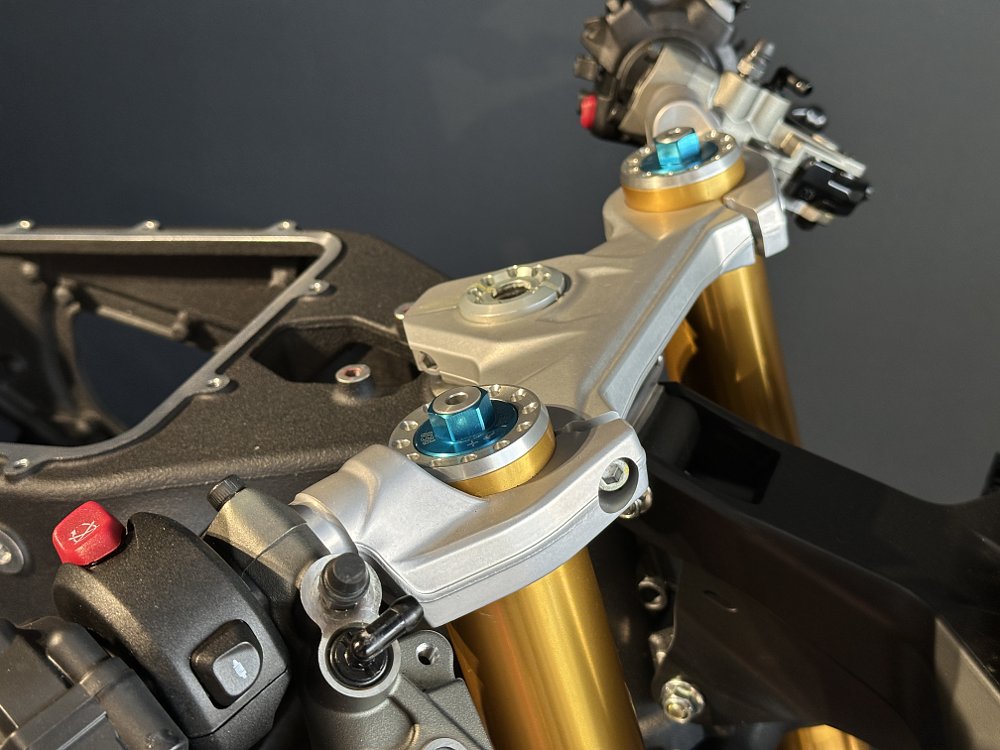Motorcycles are too fast. There, I said it. Maybe you’ve noticed that oftentimes the second-most powerful machine for sale from any given company is the better choice for most of us. And that being the case, it seems like if a manufacturer made its second-fastest machine even smaller and less powerful it would be even better. Ducati decided to give it a shot.
As Lance discussed in his first look of this new Panigale V2, the basic rundown is that it has a smaller engine that makes fewer horsepower than the outgoing V2, plus it’s lighter and has a lower starting MSRP. It’s an uncharacteristic move for Ducati as well as going against the grain of industry trends, as he pointed out, and I think it’s worth dwelling on some of the numbers now that I’ve had a look at the bike up close.
An all-new Panigale
Apart from the headline numbers for the engine — namely the 35 fewer horsepower and 21 pounds less weight from an 890 cc engine, down from 955 cc — being a clean-sheet design, Ducati’s engineers wove some tricks into the new mill that they’re pretty proud of, too. Dustin covered some of these in his first ride of the new Multistrada V2, incidentally, which uses this same all-new powerplant with a heavier flywheel and wider gear ratios.
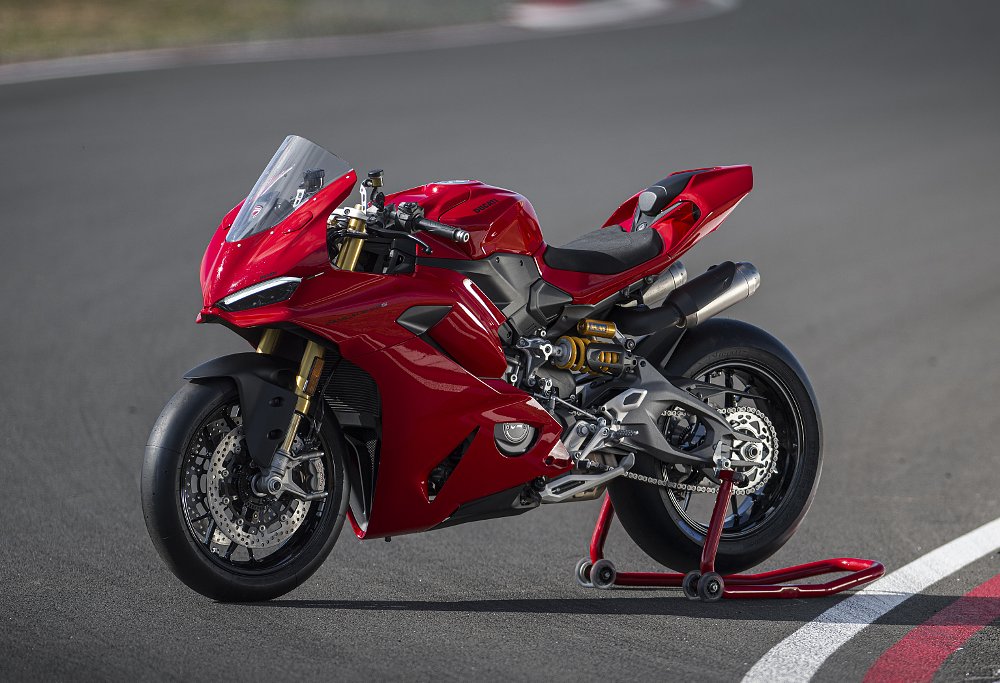
In the new Panigale V2 the engine is a stressed member of the chassis, with three main cast-aluminum branches; a monocoque box that reaches forward to the fork assembly, a rear subframe that supports the seat and tail, and a double-sided swingarm that bolts to the rear of the 90-degree V-twin.
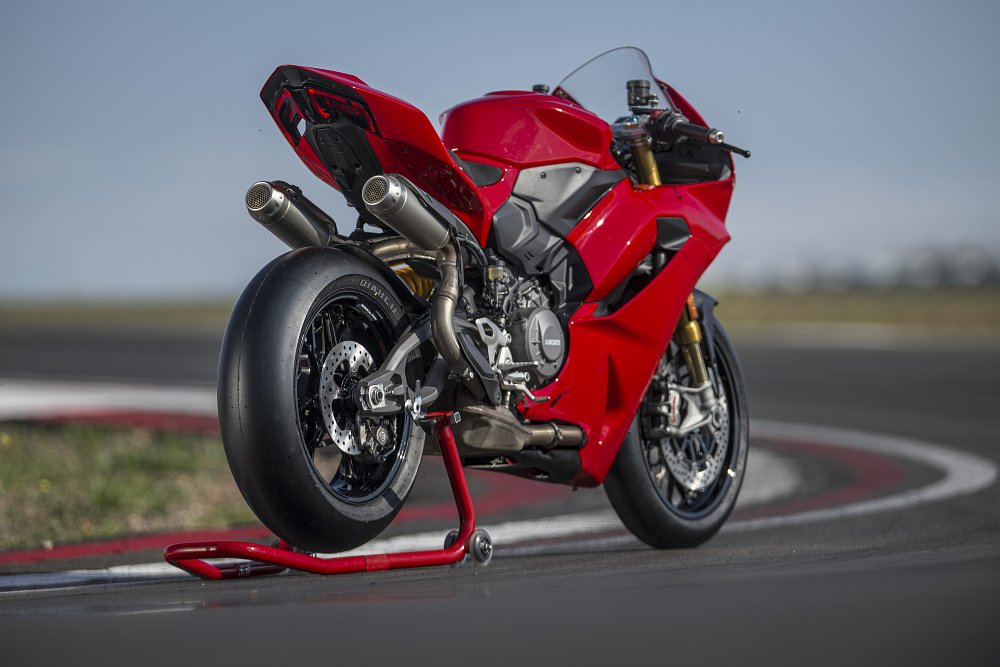
Aluminum cylinders are clamped into place by a vertically split crankcase, which provided Ducati a lot of control over where to run the channels of the water jacket. After swirling around the outside of the cylinder liners, coolant passes through a heat exchanger tucked into the notch of the V, which pulls heat out of the engine oil as well and eliminates the need for an external oil cooler. Also built into the powerplant is the quickshifter mechanism, which lives inside the gearbox rather than being controlled by a sensor on the outer linkage.
Gianluca Zattoni, the man in charge of the new V2 engine, admitted that the heat exchanger is an elegant solution for reducing external parts and cooling plumbing, but also said it annoyed him as an engine designer. Why? Weight, of course. It was his job to make the engine as light as possible, he said through a smile, and if the oil were cooled with a typical radiator then the weight of that radiator would be a problem for the chassis team, not his team.
One thing that made Zattoni’s team breathe a little easier was incorporating conventional springs instead of desmodromic valve actuation. It’s lighter and less complex, and according to Zattoni it will be cheaper to maintain. Not having the desmo system limits performance to some extent, but then that was part of the goal all along. The same goes for using variable valve timing only on the intake cam — the engine didn’t benefit enough from it on the exhaust side, so Ducati left it out.
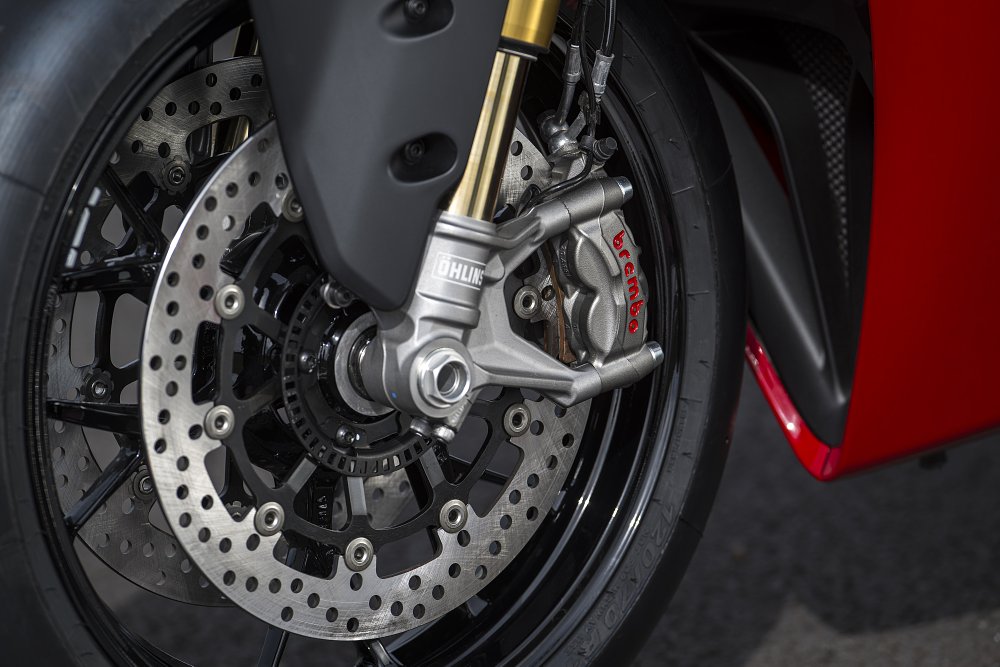
The new V2 is still big bore and short stroke and it revs just north of 11,000 rpm, but besides that it is fundamentally different from past Panigales. It’s less exotic and more practical, representing a notable shift in priorities. Ducati staff mentioned multiple times that “it is much better in terms of thermal comfort.” That’s marketing speak for “the exhaust pipe won’t roast your thighs anymore.”
If these seem like obvious changes, keep in mind that for the folks in Borgo Panigale turning away from outright power and the unapologetic resulting heat must have taken at least some group meditation. Overall, Ducati says the 2025 Panigle V2 is 37.5 pounds lighter than the previous version, or just north of 400 pounds with a full four gallons of fuel in the tank.
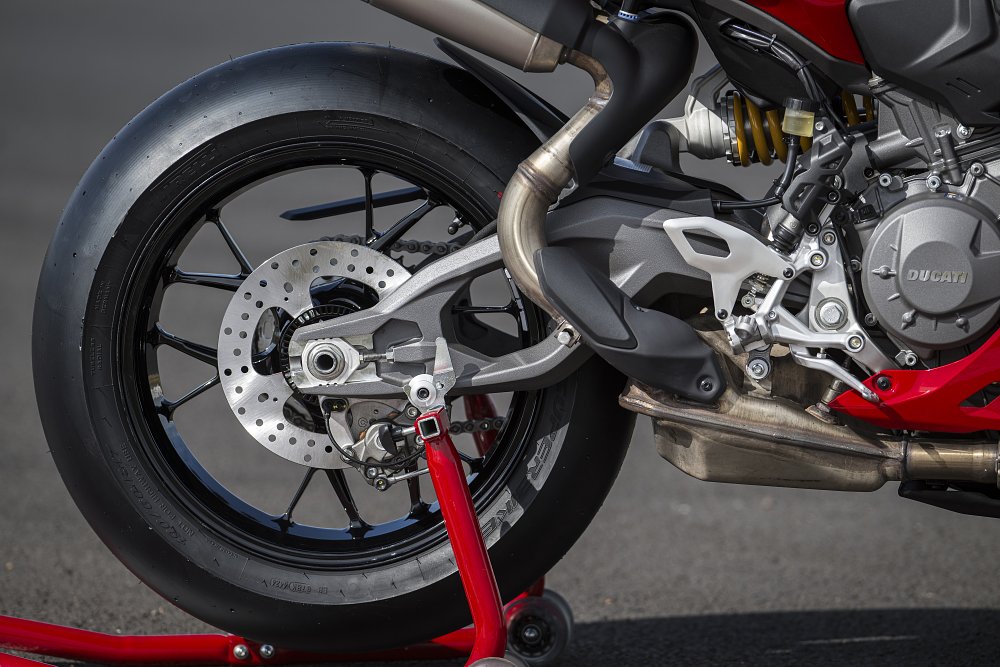
Other bits of the Panigale V2 will be more familiar. The Öhlins suspension on the S model that I tested, for example, or the standard Brembo brakes. There’s also a full suite of Ducati electronic rider aids — traction control, wheelie control, cornering ABS, engine braking, and throttle maps — all adjustable via an all-new five-inch TFT display and four-way keypad on the left switch cluster.
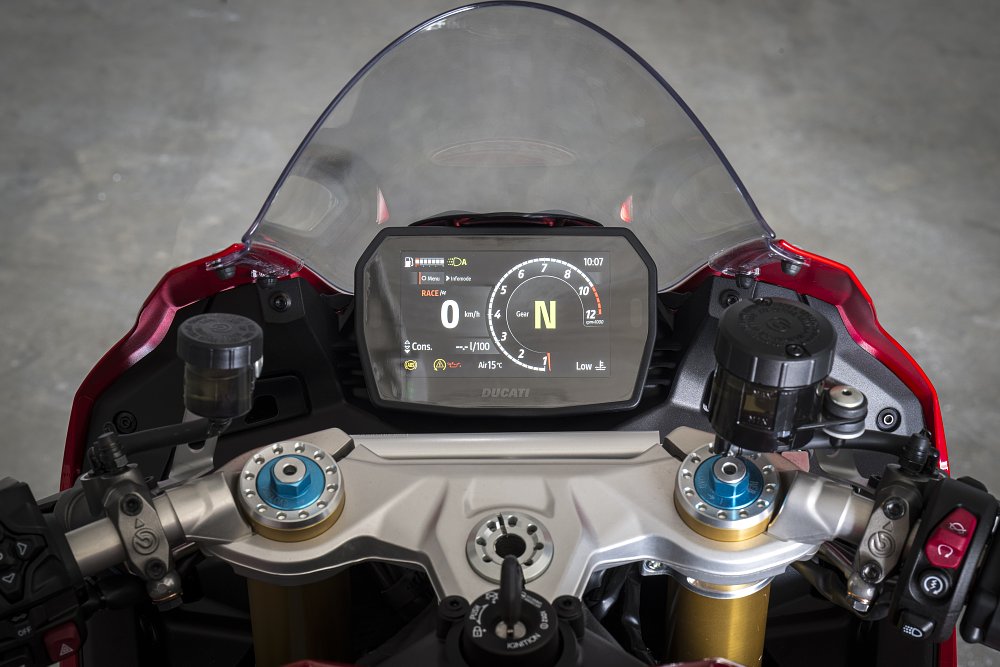
From a technical standpoint the engine is arguably the most interesting part of the newest Panigale. It represents years of design and development, while aiming at the slowly moving targets of emissions regulations and consumer demands. Even so, I think the changes made to the chassis and ergonomics are just as daring and probably more drastic, practically.
The shape of the bodywork and foundational style of the new Pani V2 has clearly been made to fit into the Panigale family, and while it shares some angles and design cues there are also clear differences. Compared to the previous Panigale V2 the handlebars are more than 2.3 inches higher and nearly 2 inches farther back, and the footpegs are 1 inch farther forward.
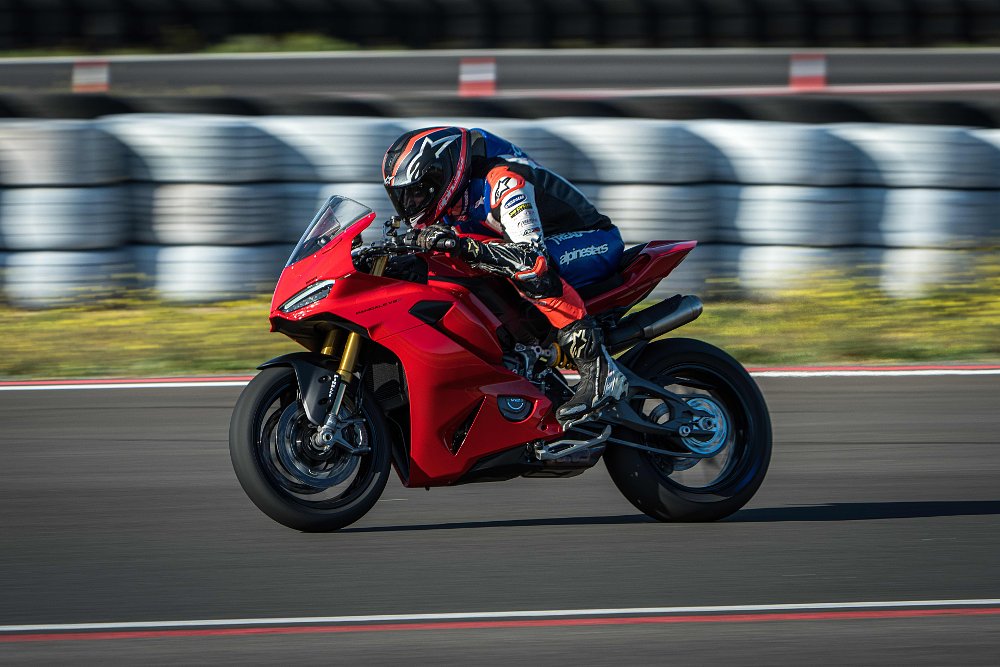
To be clear, I’m not reading between the lines here. Ducati PR and engineers were quite honest about the changes to the bike. Giulio Fabbri, Head of Product Communications, addressed the loss of overall power by saying “35 horsepower less is a lot, yes.” Paolo Quarttrino, Head of Product Management, pointed out that every other previous mid-size sport bike was based on another machine in Ducati’s lineup, and that with the previous Panigale V2 “we make riders suffer” on the road.
So, easy enough, make the new Panigale V2 more upright and accommodating, reduce power and heat, take the complexity and weight of the desmo system out of the cylinder heads, bing bang boom you’ve got a better road-going motorcycle. But, that’s never what a Panigale has been.
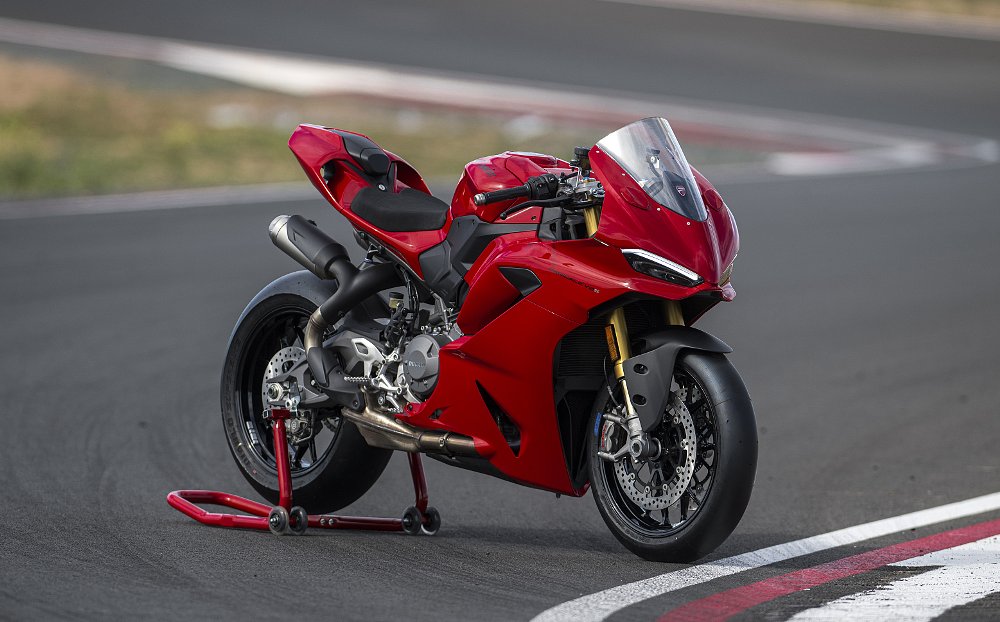
With all of that in mind, a very basic question loomed: Is it still enough motorcycle to carry the weight of the Panigale name? More bluntly, can a new Panigale that is smaller, slower in a straight line, and built for more comfort still deliver on the promise of being a true Ducati sport bike?
The new Panigale V2 on track
One of the few things that the new Panigale V2 shares with the outgoing model, apart from the name, is the seat height of about 33 inches, and my first impression of the new machine was that the saddle feels tall. The bike is narrow in the middle, as you’d expect from a mid-sized Ducati V-twin, but it’s a sizable reach from the seat to the asphalt.
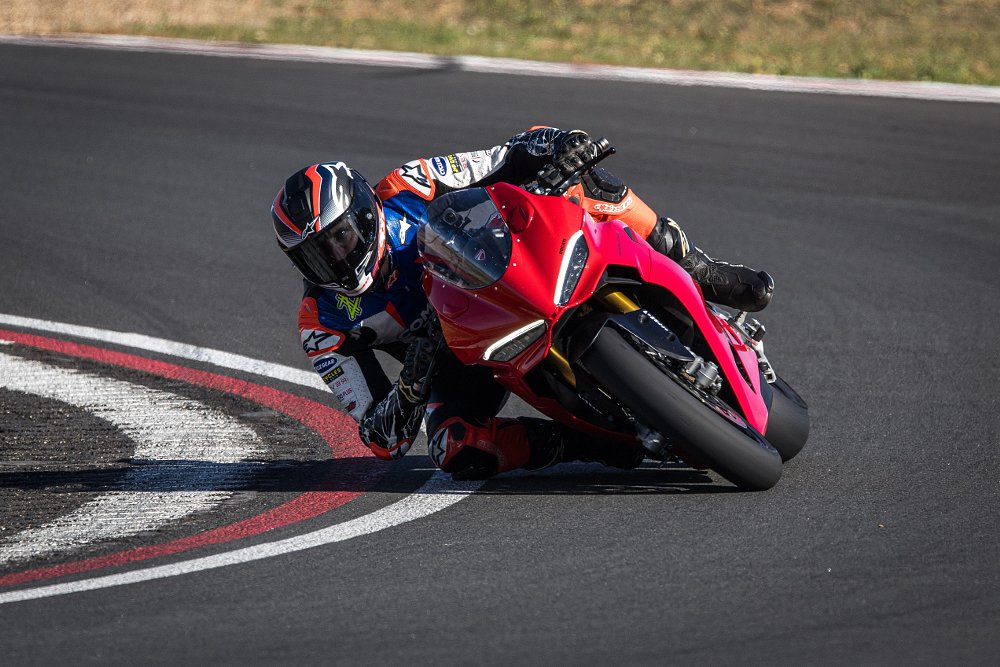
Due in part to the tall perch, there’s more legroom than I predicted. Enough so that before I’d even dropped the new V2 into gear I worried that the pegs might drag at speed on the track. The next surprise was reaching to the pseudo clip-ons mounted to the top triple clamp, which struck me as low and surprisingly aggressive considering what the spec sheet shows. A vivid illustration, I think, of how uncompromising the previous Pani V2 was for the rider.
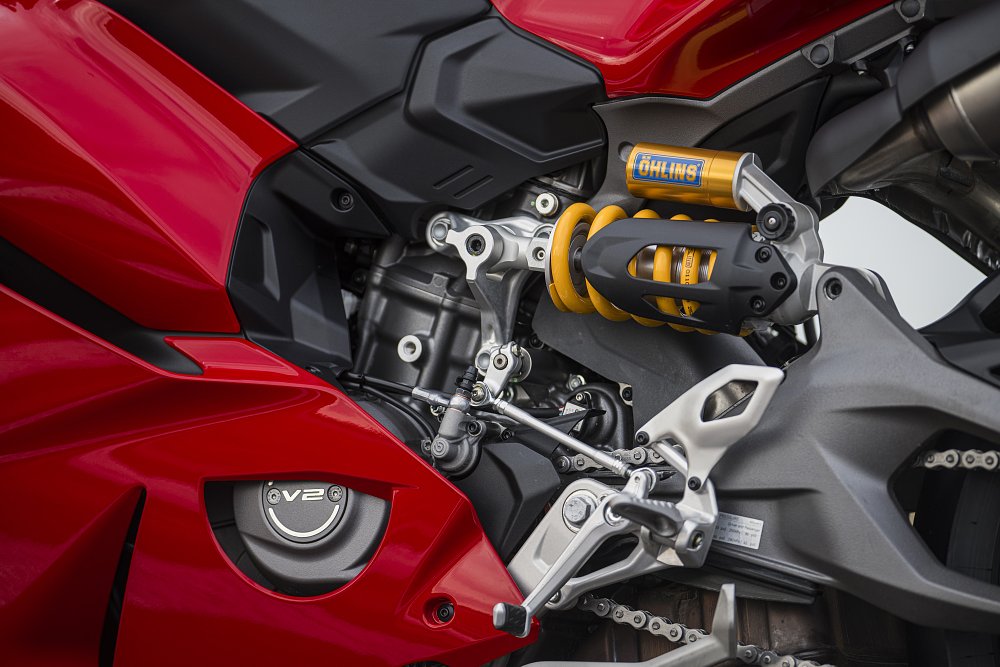
No surprise at all based on the new specifications was the character of the engine. A sharp twist of the throttle at about 6,000 rpm in second gear quickly lofted the front wheel, and with that announced a completely different dynamic for a Panigale. The previous bike would never have done that, despite having a shorter wheelbase than the new V2, unless it was nearing five-digit revs.
As I got to know the fresh, 4.1 kilometers of pavement that is the Circuito de Sevilla in Carmona, Spain, the most obvious characteristic of the new Panigale V2 was the clear gains in agility from weight reduction. The steering-head angle is a shade steeper than the outgoing V2, but I feel like it’s safe to say that shedding a few dozen pounds in total weight made the biggest difference.
Quick changes of direction were amazingly low effort and the bike tracked nicely in fast corners. Braking felt especially severe, probably in part because Ducati always fits high-end brake hardware (plus that longer wheelbase), but also less mass to slow down means it happens faster.
Acceleration was not as severe. The thrust on tap is largely as Ducati presented it — broad but not overwhelming, with the middle third of the rev range being the most impressive. The engine doesn’t have much of a top-end rush, like sport bikes often deliver, and as far as I can tell that’s for two reasons. It doesn’t have an enormous amount of total power, for one, but I also think Ducati deserves some credit for offering a strong enough mid-range hit from this new V2 that the upper revs are borderline underwhelming by comparison.
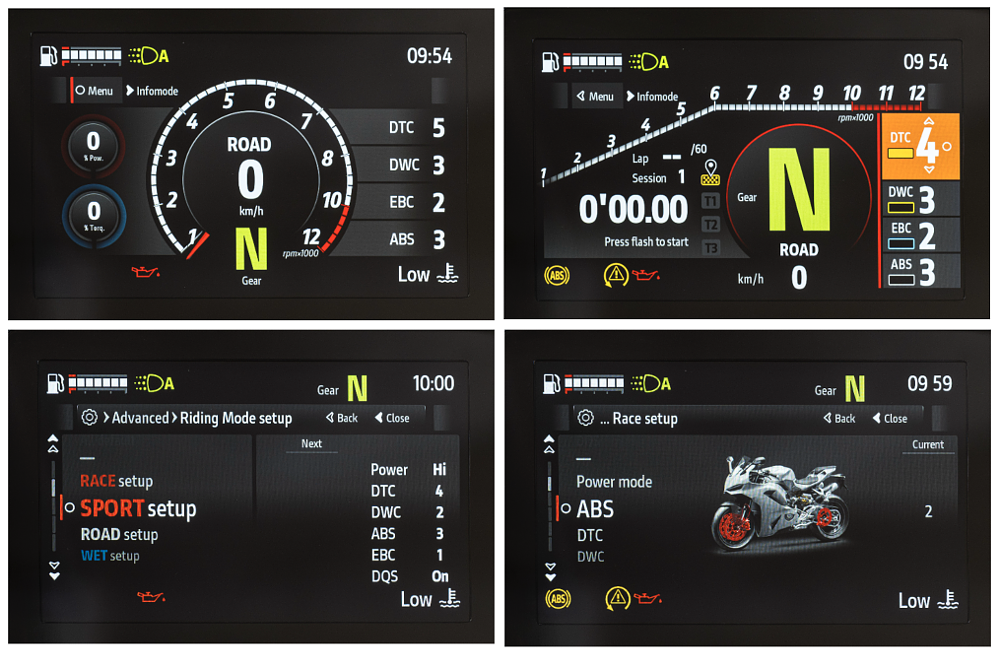
One quirk was the occasional stumble from the quickshifter, whereby I would feel some kind of misfire from the V2, always just after an upshift. The explanation was interesting: The internal quickshifter mechanism not only triggers a lapse in ignition to allow the transmission to shift gears, but it also has sensors that detect how well the cogs have meshed. If it senses that the gear isn’t fully engaged after an upshift it jostles fueling briefly to keep the bike from slipping out of gear or damaging engine internals.
It was less unnerving once I knew it was intentional, and apparently I wasn’t the only one. Other journalists I rode with noticed it as well, to the extent that the Ducati team on site said they would investigate why when they returned to the factory. Improper calibration, perhaps, or a software update is needed. Hopefully by the time you ride one, it happens less frequently.
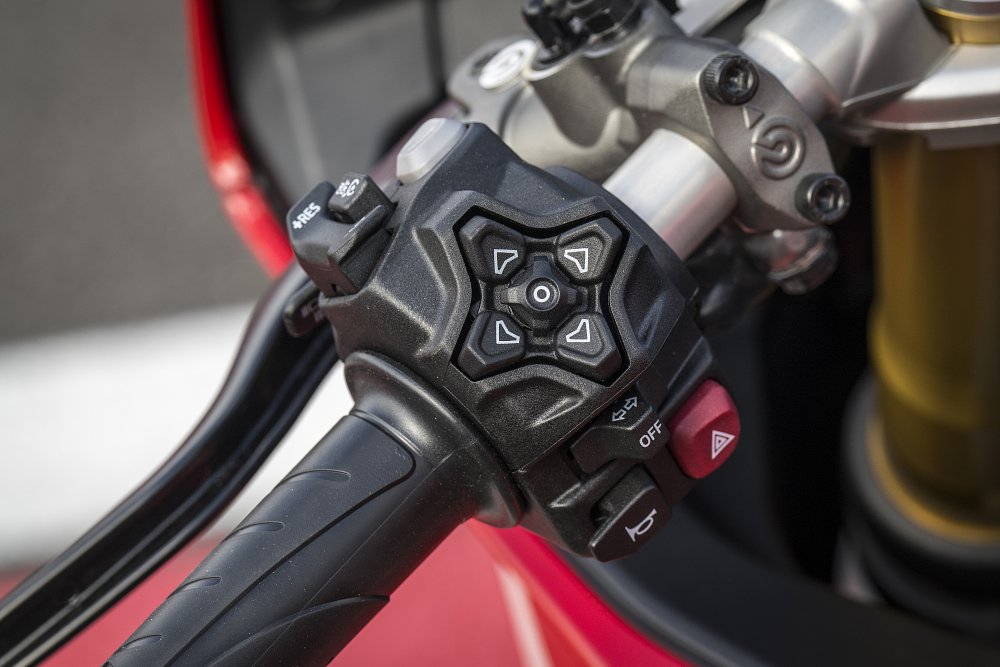
You could argue that bumping into a rev-limiter just above 11,000 rpm is a sign that the new Panigale V2 isn’t as hard-edged as previous versions, too. Ultimately, I think that’s true, and there were other signs of it. At the most aggressive parts of hard braking zones, I found the bike a little twitchy and less stable than elsewhere on the track.
There’s no fancy linked-brake system like on the flagship Panigale V4, plus the relatively low rev ceiling means the engine doesn’t tolerate race-pace gear changes that would auto-blip revs past redline during a downshift. I had to be patient and deliberate with the transmission, or override the system with that lever on the left handlebar (remember that thing?) and let the slipper clutch keep the engine from overreving.
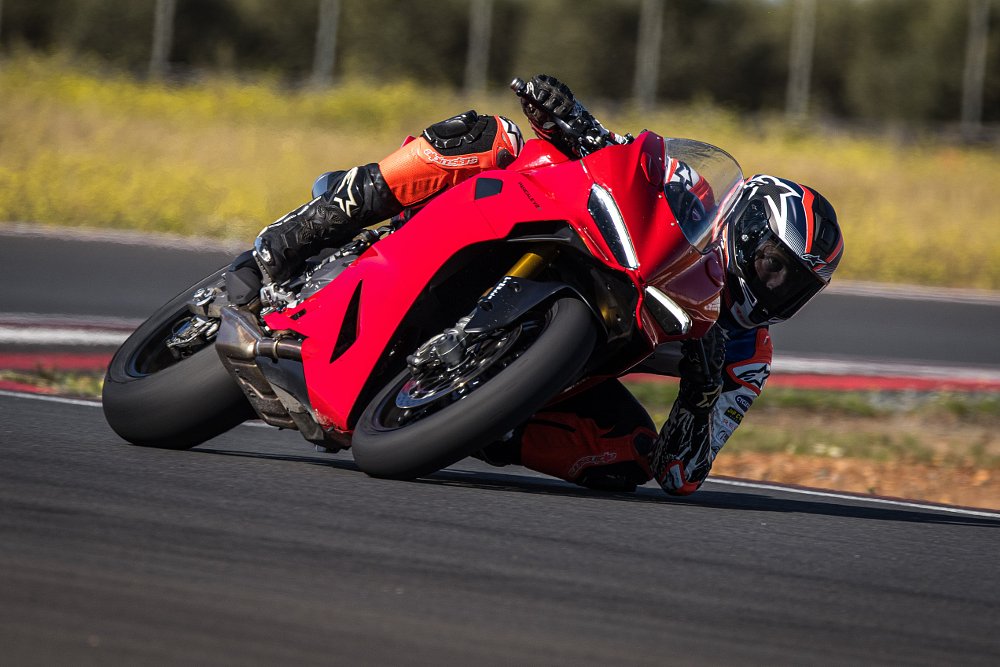
My toes scraped the ground more readily than on some other sport bikes, but I never did touch the pegs like I had worried about at the outset. Ducati staff told me a Spanish rider tested a stock Panigale V2 and registered 58 degrees of lean without touching the pegs. Something Márquez, I think. Anyway, I ended up thankful for the legroom and not concerned about dragging parts.
The overwhelming feeling I got from the Panigale V2 was simply confidence. It’s powerful enough to be exhilarating, and has a chassis and suspension to match. Without taking all of the credit away from the bike, it’s important to note that for this test the V2 was shod with Pirelli’s World SuperSport spec slicks. The tires had so much grip that I literally couldn’t manage to test the traction control system. I leaned over as far as I dared and poured on the throttle almost recklessly, still no lights on the dash.
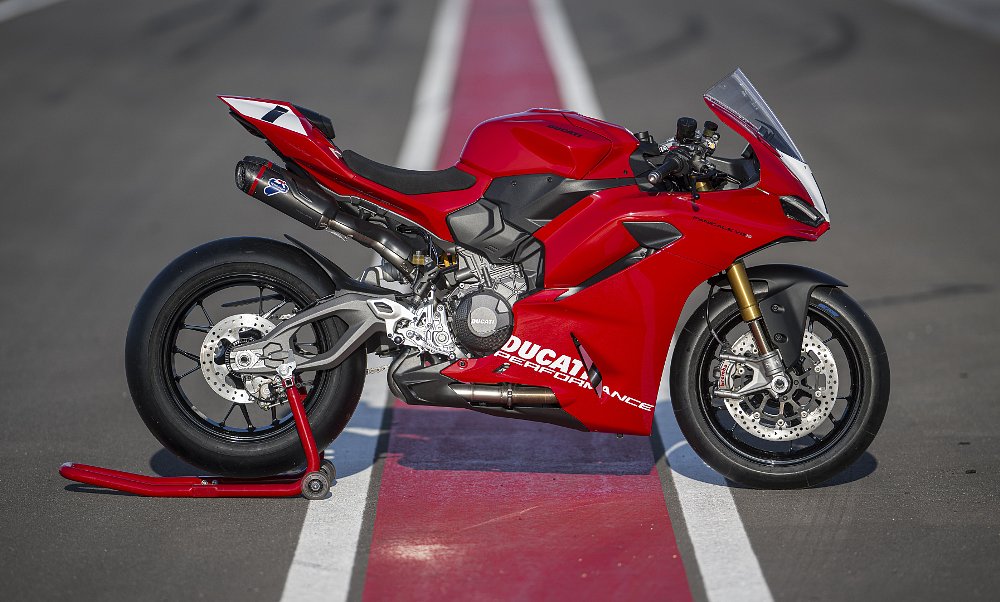
Even if the tires were a bit of a cheat code, I came away a little bit amazed that the new Panigale V2 was up for that kind of scrap. There were times when it felt less poised and less premium than its big brother, the V4, but never was it in over its head. It provided a massive amount of fun and, more importantly, a resounding answer to the question that gave me the most pause before I rode this motorcycle.
A new Panigale era begins
Yes, it’s still plenty sporty. I don’t think it’s soft, or slow, or worse in any real way that will keep riders from having a Ducati sport bike experience. I believe Ducati has gained more from making the new Panigale V2 agile and comfortable than it has lost from reducing power and complexity. I’m still kind of blown away that the famously obsessive engineers in Bologna were willing to downsize at all.
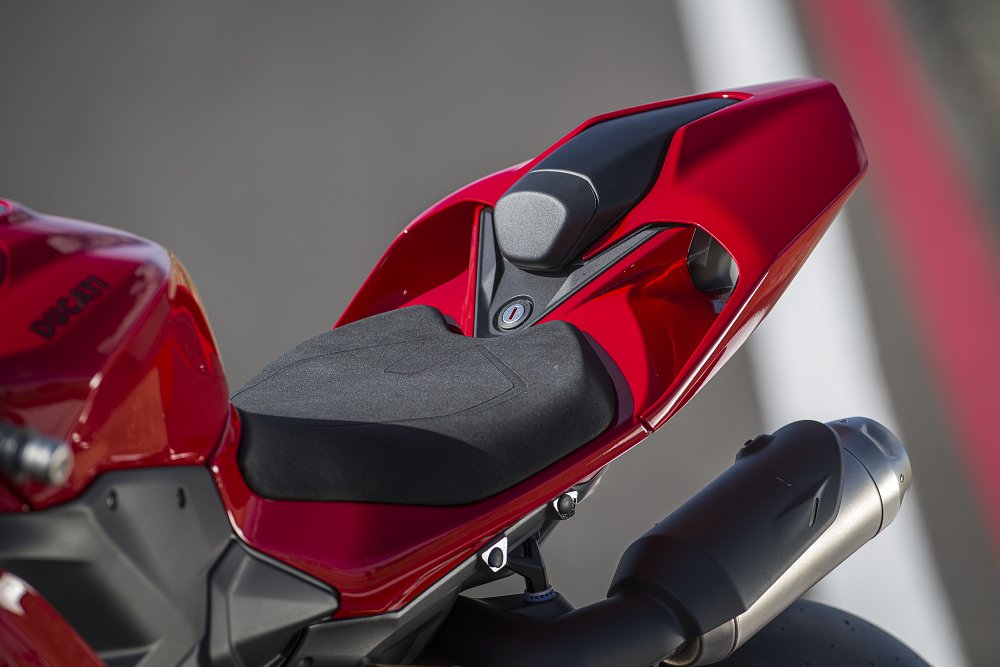
For all of the praise I’m heaping on the Panigale V2, there’s more credit due when it comes to price. The V2 S I rode for this test will be on sale for $18,995, which is pretty spicy for a mid-range machine. Then again, Ducati has never been shy about presenting as premium. The base bike shaves $3,000 off the S’s MSRP, making it just a whisker under $16,000. That’s less than the previous Panigale V2 sold for on its debut five years ago. In doing so it gives up a lithium-ion battery, Öhlins suspension, launch control, or a pit-lane limiter.
I can’t say how the base bike’s Marzocchi fork or KYB shock perform, but I know they are calibrated identically to the S model’s NIX30 fork and STX46 shock units. If the base model’s suspension is even close to the Öhlins suspenders on the S, I would be fine living without the other stuff. Three grand would buy a solid stack of Pirelli slicks.
Regardless of trim level, the new Panigale V2 sits in an interesting space. Ducati wanted more separation between the ultimate performance of its Panigale V4, and to distance the V2 from engine-size comparisons with 1,000 cc sport bikes (price comparisons will remain). It will arguably match up most directly with premium mid-range naked bikes, like KTM’s 990 Duke or the Triumph Street Triple RS.
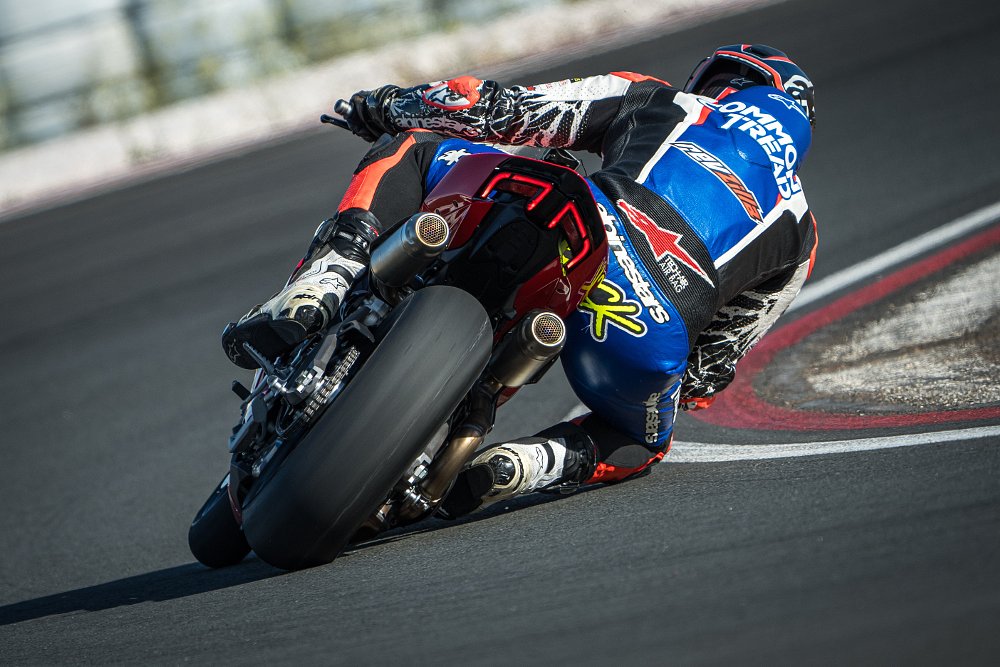
How the Panigale V2 stacks up on the street remains to be seen. I have my doubts about the 190-section rear tire, which worked well on the track but will almost certainly be overkill for day-to-day riding. How comfortable the seat is, how reasonable the handlebar height feels, and how often I use cruise control are all questions I’m interested to answer. But, on a closed course it held its own, and that is priority one for a Ducati sport bike, after all.
This is still a fast motorcycle, but it’s a clear step away from a more-is-more mentality. Over the past few years, motorcycling has seen a rise in popularity of mid-sized ADV bikes, because the market has decided that the more manageable and less expensive machine is often the better choice. We’re overdue for the same revolution in the world of sport bikes, and it seems like there’s a chance it will happen. Power to the second-most powerful.
| 2025 Ducati Panigale V2 S | |
|---|---|
| Price (MSRP) | $18,995 |
| Engine |
890 cc, liquid-cooled, eight-valve, 90-degree V-twin
|
|
Transmission, final drive |
Six-speed, chain |
| Claimed horsepower |
120 @ 10,750 rpm
|
| Claimed torque |
69 foot-pounds @ 8,250 rpm
|
| Frame | Aluminum monocoque |
| Front suspension |
Öhlins 43 mm NIX30 fork, adjustable for spring preload, rebound and compression damping; 4.7 inches of travel
|
| Rear suspension |
Öhlins STX46 shock, adjustable for spring preload, rebound and compression damping; 5.9 inches of travel
|
| Front brake |
Brembo M50 four-piston calipers, 320 mm discs with ABS
|
| Rear brake |
Brembo two-piston caliper, 245 mm disc with ABS
|
| Rake, trail | 23.6 degrees, 3.7 inches |
| Wheelbase | 57.7 inches |
| Seat height | 33.0 inches |
| Fuel capacity | 4.0 gallons |
| Tires |
Pirelli Diablo Rosso IV, 120/70R17 front, 190/55R17 rear
|
| Claimed weight | 412 pounds (388 pounds, no fuel) |
| Available | Now |
| Warranty | 24 months |
| More info | ducati.com |





